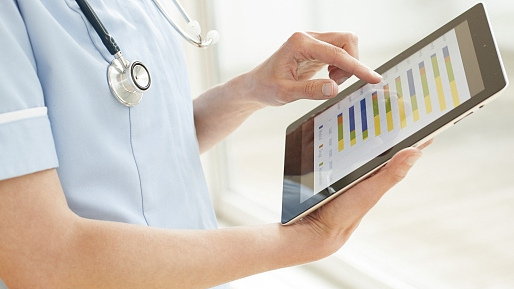
Editor's note: Anir Chowdhury is a member of the Bangladesh Prime Minister's Digital Bangladesh Task Force, and Policy Advisor to a2i, the Bangladesh government's flagship digital transformation program, jointly implemented by the Information and Communication Technology Ministry and Cabinet Office with technical support from UN Development Programme. The article reflects the author's views and not necessarily those of CGTN.
The pandemic has demonstrated something long known by developing countries but only recently realized by the richest: there are not enough doctors and nurses in the world.
There are three solutions. One, for rich countries to "import" more from poorer countries, which increases global inequalities and turns long-established brain drain into "health drain." Two, for nations to "create" more through increased training and incentivization of students to enter these fields. This takes several years. But a third option is perhaps under-appreciated, and comes with almost downside – to "stretch" existing health manpower – not through increased workload or hours, but through telemedicine.
This allows clinicians' resources to be used more efficiently, with better outcomes. The technology required is inexpensive and readily available, even to poorer nations.
Telemedicine – including simple methods like telephone consultations to assess symptoms and risk, and more complex methods like algorithmic analysis of disease patterns – can ease the load on hospitals and provide better care to patients.
The adoption of these tools has been a survival mechanism during the pandemic. But as we move beyond the virus, we should all continue to digitize our healthcare services if we want to ensure that care gets to the people who need it the most.
Many public services have a level of redundancy built into them; although this applies to healthcare, there will never be enough capacity to be ready for any future pandemics.
Telemedicine can digitally create this capacity, by allowing long-distance patient and clinician contact that comes in the form of care, advice, reminders, education, monitoring, and remote admissions.
The technology to do this is not new, but the applications have transformative effects for both patients and doctors. In the traditional system, if a patient feels feverish, he/she has to book an appointment with a doctor, queue in the waiting room and risk infecting others, or indeed become infected. Through the use of telemedicine, that individual can organize a video conference call, and could have their diagnosis conducted over the internet.
Businesses adapted to this model of communication almost instantly. While healthcare providers have been slower on the uptake, pivoting to this form of healthcare is already saving lives.
In Bangladesh, for example, the current healthcare infrastructure is relatively underfunded and many citizens live in rural areas where transport links are limited.
The government's digital innovation transformation platform, a2i, repurposed the 333 call system, originally designed to report emergencies or gain information on government services, into a COVID response line allowing symptoms to be checked and tests to be sent out. The result was that COVID-19 hotspots could be identified 7 to 10 days ahead of RT-PCR tests being conducted helping save lives.

Medical experts hold online consultations at the Telemedicine Center of the Inner Mongolia Autonomous Region in Hohhot, February 14, 2020. /Xinhua
Medical experts hold online consultations at the Telemedicine Center of the Inner Mongolia Autonomous Region in Hohhot, February 14, 2020. /Xinhua
In addition, people self reporting on 333 wanted medical advice. The country's largest ever telemedicine service was born almost overnight serving hundreds of thousands of COVID-positive patients and millions of non-COVID patients. What was remarkable was that over 4,000 doctors donated free time everyday through an Uber-like system, and tens of private telemedicine companies aggregated their services under one virtual umbrella during the height of the pandemic.
China has also embraced telemedicine. Between late 2019 and summer 2020, the number of telemedicine providers in China jumped to nearly 600 from fewer than 150, according to official Chinese data. Examples of these providers include Ping An Good Doctor, Alibaba Health and WeDoctor, an arm of the Chinese social network WeChat.
The paradigm shift is occurring all over the world. For example, the UK's National Health Service pivoted remarkably fast. In the four weeks leading up to April 12, 2020, 71 percent of general practitioner consultations were delivered remotely and about 26 percent face to face. In the same period a year ago, this was reversed: 71 percent face-to-face and 25 percent remotely.
According to McKinsey, nearly half of all American patients are now using telehealth, up from one in 10 from the previous year. The shift to online healthcare has happened, and it is here to stay.
There is still resistance, of course. Many patients, and doctors, identify (correctly, in my view) that healthcare is not simply about diagnosing symptoms and prescribing care; it is the soft skills of bedside manner and emotional support that can be equally important to recovery.
However, the quality of bedside care will only be improved as a result of less strained healthcare services. When less critical patients can be treated remotely and quickly, it frees up the clinicians' time to concentrate on those who need more care and support.
If we can work from home, we can be treated from home too. In fact, almost every public service can be improved through digitization. By making the transfer of information and services from governments to individuals instant, free and transparent, we can build more equitable societies that don't leave anyone behind. This is particularly important in the Global South where resources are limited and populations are growing.
(If you want to contribute and have specific expertise, please contact us at opinions@cgtn.com.)

